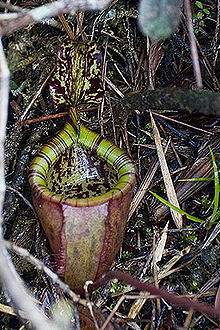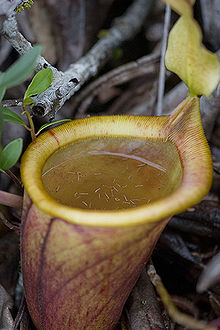- Nepenthes attenboroughii
-
Nepenthes attenboroughii 
A lower pitcher of N. attenboroughii showing the characteristic bell-shaped pitchers and upright lid of this species Scientific classification Kingdom: Plantae (unranked): Angiosperms (unranked): Eudicots (unranked): Core eudicots Order: Caryophyllales Family: Nepenthaceae Genus: Nepenthes Species: N. attenboroughii Binomial name Nepenthes attenboroughii
A.S.Rob., S.McPherson & V.B.Heinrich (2009)[1]Nepenthes attenboroughii (pronounced /nɨˈpɛnθiːz ˌætɨnˈbɜri.aɪ/ or /ˌætɨnbəˈroʊɡi.aɪ/) is a montane species of insectivorous pitcher plant of the genus Nepenthes. It is named after the celebrated broadcaster and naturalist Sir David Attenborough,[2][3] who is a keen enthusiast of the genus. The species is characterised by its large and distinctive bell-shaped lower and upper pitchers and narrow, upright lid.[1] The type specimen of N. attenboroughii was collected on the summit of Mount Victoria, an ultramafic mountain in central Palawan, the Philippines.[1]
In May 2010, the International Institute for Species Exploration at Arizona State University selected N. attenboroughii as one of the "top 10 new species described in 2009".[4][5]
Contents
Botanical history
Nepenthes attenboroughii was discovered by Alastair S. Robinson, Stewart R. McPherson and Volker B. Heinrich in June 2007, during a 2 month research expedition to catalogue the different species of pitcher plant found across the Philippine Archipelago.[6] The expedition was initiated after missionaries reported seeing giant Nepenthes on the mountain in 2000.[3][7][8]
The formal description of N. attenboroughii was published in February 2009 in the Botanical Journal of the Linnean Society. The herbarium specimen A. Robinson AR001 is the designated holotype, and is deposited at the herbarium of Palawan State University (PPC), Puerto Princesa City.[1]
Further accounts of this species appeared in McPherson's Pitcher Plants of the Old World, published in May 2009,[9] and in the December 2009 issue of the Carnivorous Plant Newsletter.[10]
 The rosette (juvenile) pitchers of N. attenboroughii demonstrate the typical bell shape of this species when only a few inches high
The rosette (juvenile) pitchers of N. attenboroughii demonstrate the typical bell shape of this species when only a few inches high
Description
Nepenthes attenboroughii is a terrestrial upright or scrambling shrub. The stem, which may be up to 3.5 cm thick, is circular in cross section and attains a height of up to 1.5 m.[1]
Leaves and pitchers
The leaves are coriaceous and sessile or sub-petiolate. The leaves of rosettes are up to 30 cm long and 10 cm wide, whereas those of the scrambling stem are up to 40 cm long and 15 cm wide. The leaves are oblong to elliptic, obtuse at the apex and shortly attenuate at the base, clasping the stem by approximately two-thirds of its circumference and becoming decurrent for 2–3 cm.[1]
Nepenthes attenboroughii produces some of the largest pitchers in the genus, sometimes exceeding those of typical N. rajah in size, but is not known to have exceeded the size and volume records set by that species.[1] The largest recorded pitcher of N. attenboroughii measured more than 1.5 litres in volume, and traps exceeding 2 litres are likely to be produced on occasion.[9] The lower pitchers are brittle and campanulate (bell-shaped), up to 30 cm tall and 16 cm wide and emerge from tendrils that are 30–40 cm long and 4–9 mm in diameter. The tendrils are flattened towards the leaf, making them almost semi-circular in cross section.
The upper pitchers are similar to the lower pitchers, but generally infundibular, to 25 cm tall and 12 cm wide.
Inflorescence
Nepenthes attenboroughii has a racemose inflorescence up to 80 cm long. The male flower spike bears approximately 100 pedicellate flowers on a rachis up to 45 cm long and is recorded to bifurcate on occasion. The flowers lack bracts and produce red tepals that are broadly ovate with an obtuse apex.
The female inflorescence is shorter, to 65 cm long, never bifurcates, and bears up to 70 densely arranged flowers on a compact rachis up to 20 cm long. The tepals are brown to purple, ovate, and have an acute apex.[1]
Distribution and habitat
This species is endemic to the Victoria Massif in Palawan. There, it grows from 1450 m above sea level to the summit of Mount Victoria at 1726 m.[11] Originally known only from Mount Victoria itself, it has since been found on a number of minor peaks and connecting ridges.[11] The species is found among shrubs 0.8–1.8 m tall in relatively scattered populations of plants on rocky, ultramafic soil. It is not sympatric with other Nepenthes species and no natural hybrids have been recorded.[1][9]
The summit flora of Mount Victoria includes Leptospermum sp., Medinilla spp., Pleomele sp., Vaccinium sp., various grasses, as well as the sundew Drosera ultramafica, which grows at similar elevations to N. attenboroughii.[12]
Carnivory
The pitchers of N. attenboroughii are open to the elements and thus often completely filled with fluid. This fluid is viscous in the lower part of the pitcher and watery above, forming two fractions that do not mix. The upper fraction supports populations of pitcher infauna, particularly mosquito larvae, and the pitchers of this species may benefit from both the usual capture of prey as well as the detritus produced by organisms living within the pitcher fluid.[1]
In the latter half of 2009, this taxon received a great deal of publicity in the national press of various countries as a sensational new plant that catches and kills rats.[13] Whilst certainly large enough to trap rodents, no rodents of any kind have yet been observed within the pitchers of this species, as indicated in the type description and through subsequent clarification by the author, who suggests that should rodents be captured by the plant, it is likely to be through misadventure rather than by design; instead, large bugs and flying insects appear to be the usual prey.[1][14]
Related species
Nepenthes attenboroughii is closely related to the Palawan species, N. deaniana, N. leonardoi,[15] N. mantalingajanensis, N. mira, and N. palawanensis (which produces even larger pitchers),[16][17] to N. peltata from Mindanao, and to N. rajah from Borneo.[1]
The stated relationship of this taxon with species from Borneo and Mindanao agrees with observations made in the description of N. mira,[18] and is further supported in the type description of N. attenboroughii by previously overlooked paleogeographical evidence. Based on this evidence, the authors reason that these species, predominantly found growing on ultramafic soils on Palawan and Mindanao, are likely to have arisen as a result of the radiative speciation of a common ancestor in Borneo.[1]
References
- ^ a b c d e f g h i j k l m Robinson, A.S., A.S. Fleischmann, S.R. McPherson, V.B. Heinrich, E.P. Gironella & C.Q. Peña 2009. A spectacular new species of Nepenthes L. (Nepenthaceae) pitcher plant from central Palawan, Philippines. Botanical Journal of the Linnean Society 159(2): 195–202. doi:10.1111/j.1095-8339.2008.00942.x
- ^ George, A. & K. Austen 2009. #AskAttenborough: Your questions answered. New Scientist, May 15, 2009.
- ^ a b Smyth, C. 2009. Giant rat-eating nepenthes plant named after David Attenborough. Times Online, August 18, 2009.
- ^ Scientists select new species for top 10 list; issue SOS. ASU News, May 20, 2010.
- ^ Top 10 - 2010: Attenborough's Pitcher. International Institute for Species Exploration.
- ^ European botanists find new Palawan plant. Manila Bulletin, October 16, 2007.
- ^ Walker, M. 2009. Giant 'meat-eating' plant found. BBC Earth News, August 11, 2009.
- ^ McPherson, S.R. 2009. The Discovery of Nepenthes attenboroughii. In: S.R. McPherson Pitcher Plants of the Old World. Volume 2. Redfern Natural History Productions, Poole. pp. 1320–1333.
- ^ a b c McPherson, S.R. 2009. Pitcher Plants of the Old World. 2 volumes. Redfern Natural History Productions, Poole.
- ^ McPherson, S. 2009. Nepenthes attenboroughii: a new species of giant pitcher plant from the Philippines. Carnivorous Plant Newsletter 38(4): 100–101.
- ^ a b McPherson, S.R. & V.B. Amoroso 2011. Field Guide to the Pitcher Plants of the Philippines. Redfern Natural History Productions, Poole.
- ^ Fleischmann, A., A.S. Robinson, S. McPherson, V. Heinrich, E. Gironella & D.A. Madulid 2011. Drosera ultramafica (Droseraceae), a new sundew species of the ultramafic flora of the Malesian highlands.PDF Blumea 56(1): 10–15.
- ^ Google 2009. Rodent-eating plant discovered in Palawan. Google News aggregator, August 18, 2009.
- ^ Robinson, A.S. 2009. Nepenthes attenboroughii in the press. CPUK Forum, August 19, 2009.
- ^ McPherson, S., G. Bourke, J. Cervancia, M. Jaunzems, E. Gironella, A. Robinson & A. Fleischmann 2011. Nepenthes leonardoi (Nepenthaceae), a new pitcher plant species from Palawan, Philippines. Carniflora Australis 8(1): 4–19.
- ^ McPherson, S., J. Cervancia, C. Lee, M. Jaunzems, A. Fleischmann, F. Mey, E. Gironella & A. Robinson 2010. Nepenthes palawanensis (Nepenthaceae), a new pitcher plant species from Sultan Peak, Palawan Island, Philippines. In: S.R. McPherson Carnivorous Plants and their Habitats. Volume 2. Redfern Natural History Productions, Poole. pp. 1332–1339.
- ^ McPherson, S. 2010. Nepenthes palawanensis: another new species of giant pitcher plant from the Philippines. Carnivorous Plant Newsletter 39(3): 89–90.
- ^ Cheek, M.R. & M.H.P. Jebb 1999. Nepenthes (Nepenthaceae) in Palawan, Philippines. Kew Bulletin 54(4): 887–895. doi:10.2307/4111166
- McPherson, S. 2011. N. attenboroughii – a new species of giant pitcher plant from the Philippines. Victorian Carnivorous Plant Society Journal 99: 12–18.
- (German) McPherson, S. & T. Gronemeyer 2008. Die Nepenthesarten der Philippinen Eine Fotodokumentation. Das Taublatt 60(1): 34–78.
- (Indonesian) Dua Malam Demi Attenboroughii. Trubus, November 3, 2008.
External links
- Photographs of N. attenboroughii at the Carnivorous Plant Photofinder
Incompletely diagnosed taxa: N. sp. Misool • N. sp. Papua • N. sp. Sulawesi
Possible extinct species: N. echinatus • N. echinosporus • N. majorCategories:- Carnivorous plants of Asia
- Nepenthes
- Flora of the Philippines
- Plants described in 2009
Wikimedia Foundation. 2010.

